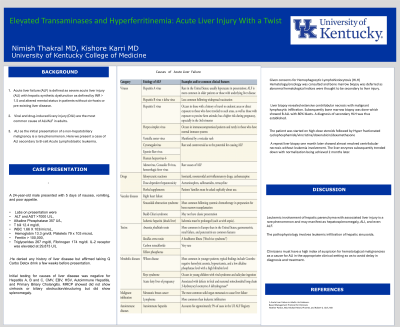Monday Poster Session
Category: Liver
P3078 - Elevated Transaminases and Hyperferritinemia: Acute Liver Injury With a Twist
Monday, October 28, 2024
10:30 AM - 4:00 PM ET
Location: Exhibit Hall E

Has Audio

Kishore Karri, MBBS, MD
University of Kentucky
Lexington, KY
Presenting Author(s)
Nimish Thakral, MD1, Kishore Karri, MBBS, MD1, Jerapas Thongpiya, MD2
1University of Kentucky, Lexington, KY; 2Texas Tech University Health Sciences Center, Lubbock, TX
Introduction: Acute liver failure (ALF) is defined as severe acute liver injury (ALI) with hepatic synthetic dysfunction as defined by INR > 1.5 and altered mental status in patients without cirrhosis or pre-existing liver disease. Viral and drug-induced livery injury (DILI) are the most common cause of ALI/ALF in adults. ALI as the initial presentation of a non-hepatobiliary malignancy is a rare phenomenon. Here we present a case of ALI secondary to B-cell Acute Lymphoblastic leukemia.
Case Description/Methods: A 24-year-old male presented with 5 days of nausea, vomiting, and poor appetite. Labs on presentation were - ALT and AST >7000 U/L, Alkaline Phosphatase 357 U/L, T bili 12.4 mg/dl, WBC 1.66 X 103/microL, Hemoglobin 13.3 gm/dl, Platelets 79 x 103 microL, Ferritin > 100,000, Triglycerides 267 mg/dl, Fibrinogen 174 mg/dl. IL-2 receptor was elevated at 29,873 U/L.He denied any history of liver disease but affirmed taking Q Carbo Detox drink a few weeks before presentation. Initial testing for causes of liver disease was negative for Hepatitis A, B and C, CMV, EBV, HSV, Autoimmune Hepatitis, and Primary Biliary Cholangitis. MRCP showed did not show cirrhosis or biliary obstruction/structuring but did show splenomegaly. Given concerns for Hemophagocytic Lymphohistiocytosis (HLH) Hematology/oncology was consulted and bone marrow biopsy was deferred as abnormal hematological indices were thought to be secondary to liver injury. Liver biopsy revealed extensive centrilobular necrosis with malignant lymphocytic infiltration. Subsequently bone marrow biopsy was done which showed B-ALL with 80% blasts. A diagnosis of secondary HLH was thus established.
The patient was started on high-dose steroids followed by Hyper fractionated cyclophosphamide/vincristine/doxorubicin/dexamethasone. A repeat liver biopsy one month later showed almost resolved centrilobular necrosis without leukemia involvement. The liver enzymes subsequently trended down with normalization being achieved 2 months later.
Discussion: Leukemic involvement of hepatic parenchyma with associated liver injury is a rare phenomenon and may manifest as hepatosplenomegaly, ALI, and even ALF. The pathophysiology involves leukemic infiltration of hepatic sinusoids. Clinicians must have a high index of suspicion for hematological malignancies as a cause for ALI in the appropriate clinical setting so as to avoid delay in diagnosis and treatment.
Disclosures:
Nimish Thakral, MD1, Kishore Karri, MBBS, MD1, Jerapas Thongpiya, MD2. P3078 - Elevated Transaminases and Hyperferritinemia: Acute Liver Injury With a Twist, ACG 2024 Annual Scientific Meeting Abstracts. Philadelphia, PA: American College of Gastroenterology.
1University of Kentucky, Lexington, KY; 2Texas Tech University Health Sciences Center, Lubbock, TX
Introduction: Acute liver failure (ALF) is defined as severe acute liver injury (ALI) with hepatic synthetic dysfunction as defined by INR > 1.5 and altered mental status in patients without cirrhosis or pre-existing liver disease. Viral and drug-induced livery injury (DILI) are the most common cause of ALI/ALF in adults. ALI as the initial presentation of a non-hepatobiliary malignancy is a rare phenomenon. Here we present a case of ALI secondary to B-cell Acute Lymphoblastic leukemia.
Case Description/Methods: A 24-year-old male presented with 5 days of nausea, vomiting, and poor appetite. Labs on presentation were - ALT and AST >7000 U/L, Alkaline Phosphatase 357 U/L, T bili 12.4 mg/dl, WBC 1.66 X 103/microL, Hemoglobin 13.3 gm/dl, Platelets 79 x 103 microL, Ferritin > 100,000, Triglycerides 267 mg/dl, Fibrinogen 174 mg/dl. IL-2 receptor was elevated at 29,873 U/L.He denied any history of liver disease but affirmed taking Q Carbo Detox drink a few weeks before presentation. Initial testing for causes of liver disease was negative for Hepatitis A, B and C, CMV, EBV, HSV, Autoimmune Hepatitis, and Primary Biliary Cholangitis. MRCP showed did not show cirrhosis or biliary obstruction/structuring but did show splenomegaly. Given concerns for Hemophagocytic Lymphohistiocytosis (HLH) Hematology/oncology was consulted and bone marrow biopsy was deferred as abnormal hematological indices were thought to be secondary to liver injury. Liver biopsy revealed extensive centrilobular necrosis with malignant lymphocytic infiltration. Subsequently bone marrow biopsy was done which showed B-ALL with 80% blasts. A diagnosis of secondary HLH was thus established.
The patient was started on high-dose steroids followed by Hyper fractionated cyclophosphamide/vincristine/doxorubicin/dexamethasone. A repeat liver biopsy one month later showed almost resolved centrilobular necrosis without leukemia involvement. The liver enzymes subsequently trended down with normalization being achieved 2 months later.
Discussion: Leukemic involvement of hepatic parenchyma with associated liver injury is a rare phenomenon and may manifest as hepatosplenomegaly, ALI, and even ALF. The pathophysiology involves leukemic infiltration of hepatic sinusoids. Clinicians must have a high index of suspicion for hematological malignancies as a cause for ALI in the appropriate clinical setting so as to avoid delay in diagnosis and treatment.
Disclosures:
Nimish Thakral indicated no relevant financial relationships.
Kishore Karri indicated no relevant financial relationships.
Jerapas Thongpiya indicated no relevant financial relationships.
Nimish Thakral, MD1, Kishore Karri, MBBS, MD1, Jerapas Thongpiya, MD2. P3078 - Elevated Transaminases and Hyperferritinemia: Acute Liver Injury With a Twist, ACG 2024 Annual Scientific Meeting Abstracts. Philadelphia, PA: American College of Gastroenterology.
